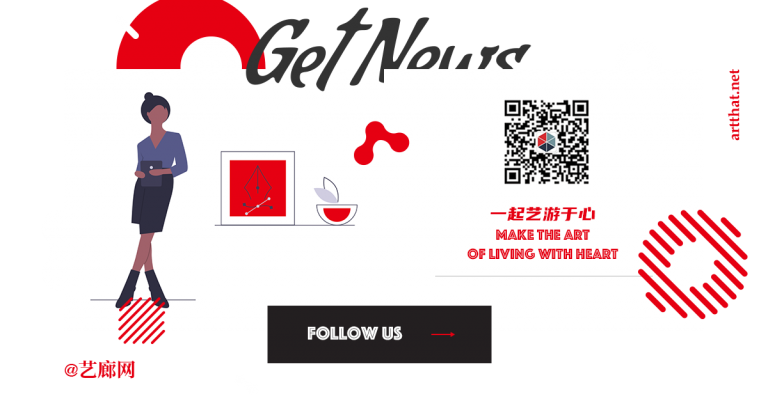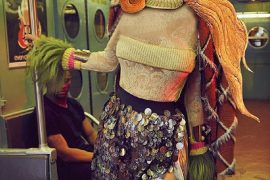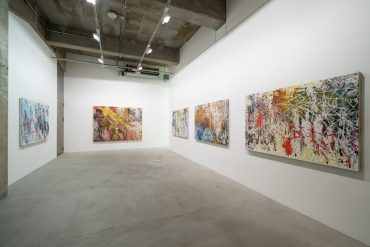How can we put on a fashion show in today’s world? When times are challenging, we must challenge our own habits.
Let us feel free to connect with other cities, other cultures. Let us attempt to be creative together—albeit from a distance. Let us dare to do what we have always done with passion: initiate a dialogue with other art forms.
Let us innovate; let us produce what can only be called a triptych. More than a fashion show: a living performance, in three acts.
At the heart of this three-part performance is a socially distanced Paris fashion show at the Garde républicaine, broadcast live on various media. The “prologue” takes place not in Paris but in New York, at the Armory Show, where choreographer Madeline Hollander will start things off with a free interpretation of the movements gleaned from Nadège Vanhée-Cybulski’s collection.
At the close of the Paris show it’ll be over to Shanghai, where dancers under the direction of choreographer Gu Jiani will conclude the triptych, injecting renewed energy and strength into the collection.
Breathing life into clothes by making them our own. Dancing a collection to infuse other bodies, other cities, with movement—even after the show is over.
Might those three moments in different parts of the world conjure up a new woman? Who knows, so swift is the pace of life…
And finally, to preserve this utopian project (what could be more utopian than fashion?), we asked Sébastien Lifshitz—a genre-crossing filmmaker steeped in modern dance and fashion—to film the last stages of the triptych’s conception.
From New York to Paris, from Paris to Shanghai, three different ways of breathing life into clothes through movement.
Three singularly different approaches, creating a sequence.
What more satisfying way, in 2021, to inhabit the world together?
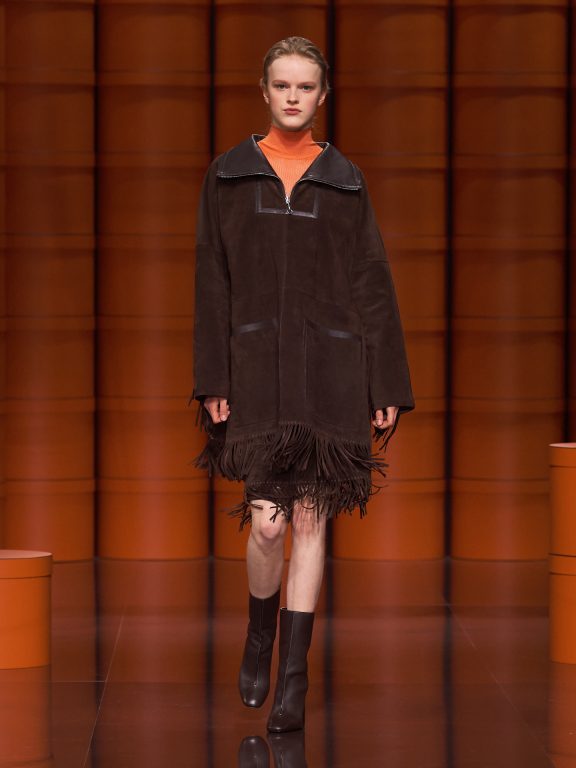
Click to view ArtThat HD: Hermès Women’s Fall – Winter 2021 Collection
Madeline Hollander & Nadège Vanhée – Cybulski, Conversation
Madeline Hollander, this triptych is taking place in unusual times. Could you describe your reaction when Hermès approached you to design a choreography for this collection?
Madeline Hollander: I had worked with Hermès in February 2020, on an event for which I composed a choreography based on the silk scarf.
I borrowed from the gestures of the new technique for producing two-sided prints, an extraordinary process whose movements I deconstructed—inspired by the workshops, where each gesture counts. I was struck by the movement of clothes worn for the first time. I needed to find within the triptych the balance between gesture, movement, stepping, and choreography necessary for a natural, organic dialogue.
Nadège and I came to discuss fabrics, and the incredible quantity of fabrics in her collection, and also the sensuality of certain textures, certain colors.
Has your work always depended on minute observation?
M H: I find inspiration in the movements of everyday life. They express a reality I explore through close observation, analysis, and dissection. The way people walk in the street, cross an intersection; I bring patient study and a quasi-scientific approach to this type of thing.
So your choreography is based on everyday life. Is a fashion show a choreography?
M H: Yes, I’ve always been fascinated by people’s walking styles.
Once I see a certain kind of walk, my work can begin! There is in each fashion show the potential to extract a certain kind of walk and use it as a point of departure for a choreography. But for this particular project, I was not so sure, and neither was Nadège: should we use the fashion show as inspiration or not, given that the show would come afterwards, in the Parisian sequence.
The more Nadège and I worked, the more I understood that she was specifically interested in New York.
For me, this project was also the opportunity to work with professional dancers, perpetual purveyors of grace through motion. Clothing plays an interesting role here, because when a model wears something it doesn’t move the same way as when a dancer wears it. Dancers bring something else to the table, perhaps something more ample…
Nadège Vanhée-Cybulski, when you were putting together this triptych, what role did New York play in your thinking?
Nadège Vanhée-Cybulski: For Shanghai, there was an attraction to tradition, but for New York I didn’t have a precise idea. I knew I didn’t want the performance to resemble the show too closely; that was all. I was interested in Madeline’s obsession with gesture. I thought it would be a perfect way to open the triptych, and I was curious to see how she was going to make the collection her own, interpret it before the show was produced. It is interesting to see what Madeline does with an article of clothing: for her it is not a piece of clothing on a body, but movement renewed. I am interested in the relationship between clothes, bodies, and attitudes; these are the things I think of when I begin designing a new collection. I had been fascinated by one of Madeline’s choreographies, “52 Final Bows”, which was the inspiration for the curtains. My collaboration with Gu Jiani was predicated on the physical, whereas Madeline’s approach is more theoretical: the conceptual basis of the project and its structure are in fact revealed in her work. She was the ideal partner for the opening. In retrospect, I realize that the difference of those two approaches inspired the collection as it was being made.
Did both artists get carte blanche?
N V-C: Not exactly. We had some ground rules, regarding colors, that couldn’t be changed. As for the clothes, both choice and interpretation remained completely open. I was interested in what these two choreographers could bring me, not the other way around… We responded to Madeline’s work on walking styles with wrap pleated, and frill dresses and skirts in georgette that allow movement, the pleats echoing the curtains. Each of the moments of this triptych has its own life, its own identity; they are true moments of creativity. This is where the ubiquity I have mentioned factors in.
So Madeline, is your choreography a commentary on the energy and movement one finds in New York?
M H: Absolutely. It is a commentary on the movement of New York pedestrians rather than on fashion. I love watching people walk the streets of Manhattan in the morning; their movements are very rhythmic and sometimes synchronized. They say that New Yorkers walk 3.2 mph on average, and for me that speed is an inextinguishable source of inspiration.
Nadège and I discussed “The Red Shoes”, a 1948 film by Michael Powell and Emeric Pressburger, in which choreography is generated by the shoes, not the body, as well as the spell they cast on the dancer. What a fantastic idea! And that is what came to mind when I was asked for a choreography with clothes… how clothing influences our way of being, dancing, and moving.
How clothing inspires the movements as if by magic… they become the choreographer.
Nadège, you mentioned the curtains—did they come up with Madeline? How prevalent were the curtains in your discussions?
N V-C: At first, we talked about the black lodge in “Twin Peaks” by David Lynch: a red room with red curtains separating two worlds. Then, a movie theater with the screen separated in a closed space. There are no curtains in movie theatres anymore, which is a shame, though one still finds them in traditional playhouses, so we decided to focus on that in the staging. Curtains symbolize promise. One always wants to know what is behind the curtain; it’s irresistible. Curtains have long been partitions for women.
So for me these curtains are both spectacular and mysteriously intimate…
M H: The curtains helped me think of the prologue. Right before the curtain is lifted, I hear the sound of the orchestra tuning. I like to feel that communal creative tension, the excitement of the opening…
Nadège said earlier that there was an implied promise in those curtains. It is also about sensuality…
M H: My work begins by studying people’s walks in New York in the morning. At that early hour there are two distinct rhythms: some forcible, power-oriented, decision-making. Others adopt a leisurely pace, traversing the city more circuitously. So, we have two distinct territories that both possess unique forms of sensuality. How to associate them? To guide each toward the other?
Can one dance a collection, dance a situation as complex as the one in which we currently find ourselves? And isn’t this performance a kind of collective self-portrait?
N V-C: I would say a snapshot. Whatever we produce carries within it a portrait of the moment. We are living in singular times, and are faced with singular creative challenges.
The moment we are currently experiencing is important because it is changing everything we think we know. We are rethinking our connection to other people. We have an increasingly local focus, which is both constraining as well as a wonderful opportunity—that we have attempted to weave into this triptych: we in Paris, Madeline in New York, Gu Jiani in Shanghai. And it is vital that each participant has a strictly personal and intimate approach to where they live and to what is happening now.
Would we have created this new vocabulary, these socially distanced collaborations if things had been calmer, more normal? Probably not.
We would have undoubtedly produced a more traditional show. We want to comprehend the moment and invent new ways of working together.
M H: For me, this performance is not just about clothes or about a performance. The current situation has forced us to reinvent ourselves and the production process from the inside out: despite the crisis we must continue to collaborate and discover creative ways to leap over obstacles. New ways of functioning and performing will, I’m sure, emerge from these constraints.
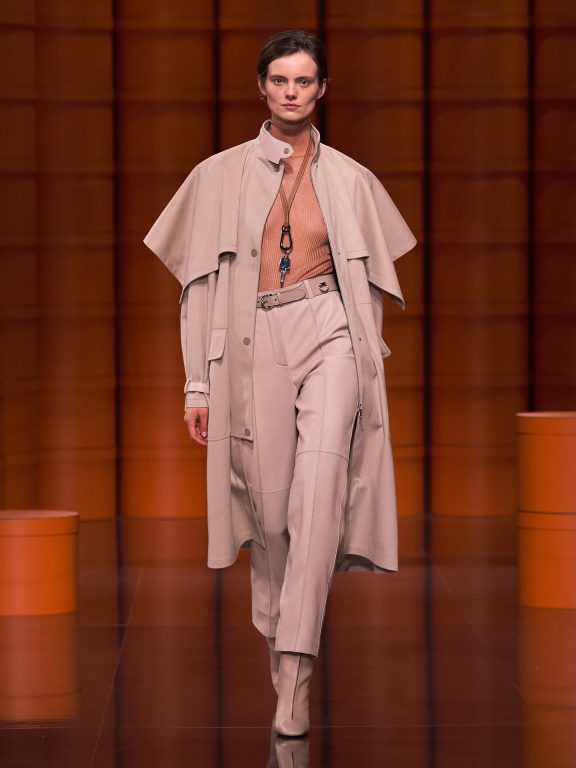
Gu Jiani & Nadège Vanhée – Cybulski, Conversation
A Paris show supplemented by two choreographies, each an expression of a culture and a continent. Nadège Vanhée-Cybulski, how did this idea come about?
Nadège Vanhée-Cybulski: Very straightforwardly, out of a question: how in these socially distanced times can we continue to be creative and, more importantly, be together despite it all? If we cannot go anywhere, if we cannot travel, then the show will have to come to us… And that is how we came to the idea of something beyond an actual, physical performance. Then we decided to connect three distinct places, so that the collection itself would travel to the three cities and find its own way of inhabiting the space.
Simultaneity?
N V-C: I was more interested in ubiquity. I wanted to know how the collection could feed off and contribute to the energy of three very different cities. We wanted artists to take over the project and interpret my work using their own language, their own discipline. That is why we chose local choreographers. When I was introduced to the work of these two young women—Madeline Hollander, and Gu Jiani—it seemed like a no-brainer.
I fell in love, actually, for each has her own way of expressing female power. There was something exalted in their approach to dance. This passion characterizes Gu Jiani’s work, which constantly strives to strike a balance between risk-taking and poise.
We wanted to present the contemporary woman in movement. Dance is the language of the body, the transmutation of a state of mind, of the spirit.
Gu Jiani, how did you react when you were invited by Hermès to join this innovative project?
Gu Jiani: After the immobility that has hemmed us all in for so long, my initial reaction was to resist the lazy idea of creating a choreography using outfits by Nadège.
I had to look elsewhere, and meditate on the spirit of the collection, its values, its vision of the moment we are all experiencing, and compose a choreography inspired by these clothes. The movement interprets the clothing, not the other way around. This approach is in fact very different from my usual way of working; the outfit is almost never the starting point of a new creation. Which is why the first time Nadège and I spoke we discussed what was most important to us: the dialogue between clothing and dance.
To find common interests and shared values.
Nadège, how did you present this new collection to Gu Jiani?
N V-C: I avoided speaking in general terms. I wanted to meet her ever since I saw her work. In fact, I believe I used different images for each choreographer. Gu Jiani made me think of geometry, a geometry I perceived in her choreographies, and which I then found in my collection. It was a kind of port of entry, a way of initiating dialogue: the tension between verticals and horizontals. The color chart also played an important role. I wanted Gu Jiani to feel inspired by our graphics, and free to explore the essential—that is, what lies behind the clothing, for we are both focused on showing that women are as strong as they are sensuous. A woman in movement. Gu Jiani chose the Tattersall equestrian check because it defines a framework in both the literal and figurative sense.
Gu Jiani, how does one go about interpreting a collection through movement?
G J: It was crucial for me to grasp that Nadège wanted a choreography steeped in Chinese tradition, in a certain culture of movement, and that she desired a true collaboration. She supplied a generous number of visual materials including her mood board, references and photos of the collection, so I was able to freely come up with ideas… and so we ventured forth together and forged a common interpretation of the clothing.
N V-C: It is a pleasure to see my own language interpreted in a form I am unfamiliar with, and which inspires me. It is an incredible privilege—and even more so now—to be able to show one’s work to and share it with someone from an entirely different background. I must say it shook up my work habits.
Experimentation in classical or neoclassical forms has always been my way of making my own voice heard whilst hopefully making my influence felt on the Hermès brand. I like to search the archives for a particular pattern that the collection might completely reinterpret.
Is this taste for experimentation what you meant by the risk-taking you were discussing earlier with Gu Jiani?
N V-C: For me, risk-taking is the very definition of experimentation. We are all caught up in a moment of reflection about what we can do better, and differently. We need to rethink certain things positively; if not, all the questioning linked to the pandemic will have been fruitless. We can and must welcome different sensibilities into our own work.
For me, communicating with Gu Jiani and the production teams was enriching; far from keeping me from working, it helped me look differently upon certain aspects of my work.
Gu Jiani, how did you incorporate the Hermès boxes into your choreography?
G J: The first video which I believe struck Nadège and her teams was a choreography in which I played very athletically, very energetically, with boxes. In China, boxes are ubiquitous. It is such a commonplace object that everyone can relate to. I noticed that composing a choreography out of boxes had intrigued the creative team in Paris, where boxes symbolize gifts, presents, surprises. Here again it was interesting to see how each of us managed to surprise the other by just being ourselves.
Using boxes like building blocks on the stage invites the audience to look at them differently, like sliding walls, partitions that can be played with.
Obstacles turn into bridges. Spaces are transformed instantly. So we are dealing with the concept of rules, which for me is symbolized by the Tattersall pattern.
N V-C: When Gu Jiani decided to use the box as a theme— a universal object—it was both startling and intuitive, since the box is fundamental to Hermès. Our orange boxes have a long history; they are part and parcel of Hermès. It seemed appropriate to include them in the staging since they symbolize our identity. The history of these boxes is synonymous with the boldness but also the quality one associates with Hermès. Boldness means finding solutions and reinventing oneself using what is available, and building something beautiful despite the constraints of the moment—while reaffirming one’s creativity. Originally the boxes were white, but because of the scarcity of white paper during the war they changed, orange being the only readily available color. Thus orange became symbolic, and is now a kind of common denominator in this triptych.
Nadège, you were saying that your new collection attempted to attain a balance between affirmation, strength and sensuality through femininity…
N V-C: The idea was female sensuality completely reappropriated.
Women’s sensuality was forever described, filmed, photographed, and painted by men. The choreographers we approached were women. This was not fortuitous. We are living in a time when women need to take control of the narrative, express their sensuality as they see fit, far from all stereotypes.
It is an ongoing process—and a wonderful challenge—for today’s women, and for fashion.
G J: Yes, I agree with Nadège, I share her vision. For centuries men imposed their idea of feminine sensuality, whereas nowadays women can affirm their own vision. The idea of an independent woman is no longer a contradiction in terms. All of this points to new movements that we dancers can begin to explore.
Discuss in Kanban. Welcome to search “艺廊网”, “artthat” and follow us on WeChat and Weibo.
Now join ArtThat Elites Club, then re-create with artists and take silk-screen handwork home!
